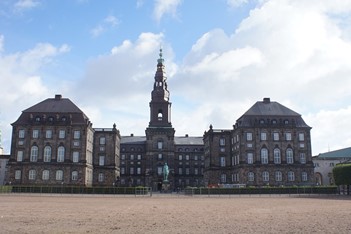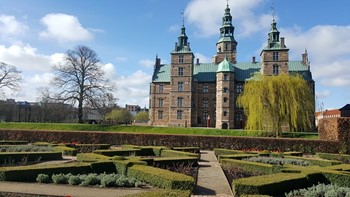Feel like a royal in Copenhagen
Denmark is home to one of oldest monarchies in the world with a history tracing back to the Viking Age. You can see this history everywhere in Copenhagen, with its cobblestones, statues and monuments but especially in the castles, palaces and royal gardens.
Christiansborg Palace
Once home of kings and queens, this 800 year old royal palace now houses the Danish Parliament, Supreme Court and Ministry of State. Parts of the Christiansborg Palace are still used by the royal family for various functions and event, such as gala banquets and public audiences.
You can visit the palace on Slotsholmen when the royal family isn’t using it, you can explore parts on your own or go on a guided tour. The five parts of the palace which are open to exploration include the Royal Reception Rooms with the Great Hall and the Queen’s tapestries, the Royal Stables, the Royal Kitchen, the Christiansborg Palace Chapel, and the Ruins under the palace.
The current palace was completed in 1928, the Ruins underneath are 800 years old. The largest and oldest ruin under the palace is the curtain wall from Bishop Absalon’s 12th century castle. The curtain wall protected the castle from Wendish pirates that attacked Copenhagen from the south. Absalon put their severed heads on stakes outside the castle walls to inspire fear and serve as a warning to the pirates.
Amalienborg Palace
As the official winter residence of the royal family, Amalienborg Palace is a must-see for anyone with a taste for royalty. The palace consists of four different buildings which flank a square, which were built by noble families in the middle of the 18th century on direct orders of then king Frederik V. The palace is considered to be one of the great masterpieces of Rococo architecture in Europe. The statue in the middle of the square, of Christian IX, was sculpted by French artist Saly.
Every day at noon, you can watch the changing of the royal guards, Den Kongelige Livgarde, in the court yard. When the Queen is in residence the guards are accompanied by the Royal Guards music band. If, instead, one of the royal princes is residing at the palace in the capacity of regent, the guards are accompanied by drums and flutes.
The Amalienborg Museum exhibits he private interiors of the most recent kings and queens and an exhibit on the monarchy today with its many traditions. In June, July and August you can also visit the Royal Reception Rooms, the Gala Hall and other state rooms which are still in use today.
Rosenborg Castle and The King’s Garden

The 400 year old castle, built in the Dutch Rennaissance style, was built because the old medieval castle, Copenhagen Castle, was hopelessly old-fashioned and the young king, Christian IV desired a castle that befitted him. The castle started as a small summer palace but over the course of 28 years it went through four stages of development to become the castle it still is today.
Among the main attractions of Rosenborg Castle is the Knight’s Hall with the coronation thrones and three life-size silver lions standing guard. The tapestries on the walls commemorate battles between Denmark and Sweden. The other top attraction is the crown jewels and the crown regalia which are part of the De Danske Kongers Kronologiske Samlinger (Royal Danish Chronological Collections) including everything from paintings, chinaware to silver.
The King’s Garden is Denmark’s oldest royal garden and is open to the public. Among the attractions to be enjoyed here are the impressive herbaceous borders, numerous historical sculptures, and Krumspringet ('The Caper') - a restored Renaissance park with a pavilion, espaliers and rose gardens.
Frederiksberg Palace
Though officially not in Copenhagen and not to be confused with Frederiksborg Castle, Frederiksberg Palace and its gardens are today surrounded by Copenhagen which grew around the royal grounds and border the Copenhagen Zoo. The palace is now owned by the Ministry of Defence and used by the Royal Military Academy.
The palace has numerous fine rooms and a Baroque palace chapel. In the basement you can still see the large bath and mirror over the bathtub installed for King Christian VII, who married Princess Caroline Matilde of Great Britain. You can take a guided tour of Frederiksberg Palace on the last Saturday of each month.
